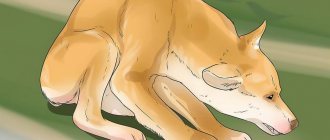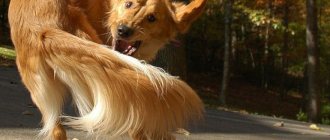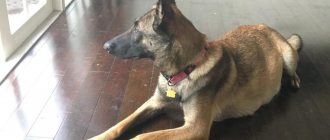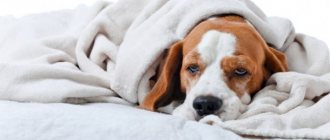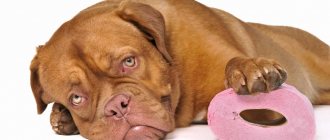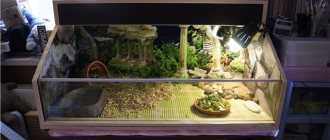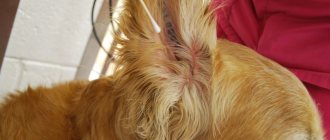Intestinal volvulus in a dog - as a rule, such a phrase evokes only one association among animal owners: a dangerous situation that inevitably leads to the death of the animal. In fact, this is not entirely true. Early recognition of the disease and immediate assistance can save your dog.
So, what is volvulus?
This is a situation in which one part of the intestine rotates in relation to another. The disease is acute, with expansion and causes considerable pain in the dog.
The most terrible development of this is a condition in which the death of living intestinal tissue gradually begins to occur, in other words - necrosis. Then the pet will die.
To prevent such a sad outcome, owners should be extremely careful and call emergency veterinary help or take the dog to the doctor as soon as the first symptoms of this disease are noticeable.
What is volvulus?
Before we begin to describe methods of treating volvulus, it is important to understand what this pathology is. The intestine itself stretches up to seven and a half meters in length (in some breeds), and is held in its position thanks to special ligaments - mesenteries, which are involved in blood circulation.
If for some reason the mesenteries become overtightened, then this process is accompanied by a circulatory disorder, which results in the gradual death of the compressed intestinal tissue. In the worst case scenario, the dog begins a necrotic process, which can lead to death in the absence of medical assistance.
Volvulus is a life-threatening condition for dogs.
Types of volvulus
The twist itself suggests two main scenarios:
- the mesenteries twist in such a way that they compress the artery, disrupting the entire circulatory system in the intestinal area. All this leads to the fact that blood flow stops;
- displacement of the lower intestine, which compresses the large intestine.
It should be noted that there are other scenarios for the occurrence of volvulus, depending on which particular organ segment is “under attack.” It doesn’t make much sense to list all these scenarios, since they all have common symptoms, and finding out who causes the bloat is already the task of the veterinarian.
Comparison of the stomach in a normal state and in a state of volvulus
Intestinal volvulus also leads to gastric volvulus, as a result of which the pet’s condition becomes even worse. It should be noted that gastric volvulus is quite rare. The most common cause of a sharp enlargement of the stomach in dogs is excessive gas formation. However, in some cases, gastric volvulus appears due to chronic bloating.
What influences the development of pathology
Volvulus occurs more often in large, heavy dogs. Older animals are more likely than younger ones to end up on the operating table. This is due to the weakening of the gastric ligaments throughout life.
Poor nutrition
Owners prefer to feed their pet 1-2 times a day in large portions. If the animal has a predisposition to diseases of the digestive system, it is recommended to change this scheme. The pet is fed 3 times a day in small portions.
It is important to choose high-quality dry food. Bones and cereals that cause bloating and excessive gas formation are not included in the diet.
Genetics
Before buying a puppy, they are interested in the presence of gastric pathologies in the parents of the future pet. Veterinarians believe that hereditary factors play an important role in the development of bloat in a young dog.
Physical activity after meals
At least an hour should pass between the last meal and the dog's walk in the fresh air.
This rule can protect an animal of any breed. Weak ligaments are not able to hold a dog’s full, stretched stomach in its normal position while running and jumping.
Chronic diseases
Pathologies of the digestive system and gastrointestinal diseases (gastritis, ulcers, duodenitis, neoplasms) increase the risk of bloat. This occurs due to disruption of the proper functioning of the stomach.
It is important to identify these problems early and treat them promptly.
Pet's temperament
Active, cheerful dogs are less likely to suffer from this pathology than their phlegmatic or restless and anxious counterparts.
Symptoms of volvulus
Volvulus is not one of the hidden diseases that are recognized months or even years after its onset. This disease always occurs in an acute form and involves severe suffering for the dog, which in one way or another demonstrates it. Of course, an owner who does not have specific knowledge in veterinary medicine may not recognize the pathology itself, but he can easily understand that his pet is not in order.
Volvulus has pronounced symptoms
We will talk about common manifestations characteristic of dogs with volvulus in this chapter.
Swelling of the abdomen
The pet's belly becomes unnaturally large and at the same time very painful. The animal can react sharply and aggressively to the owner’s attempts to touch it. The abdominal wall feels hard and stretched to the touch. All these manifestations indicate that the dog’s intestines have become inflamed and grown in size.
External signs of pain
Even at the first glance at your pet, it becomes obvious that he is in pain. These intense sensations can be recognized by the dog's posture - when the intestines are twisted, it is difficult for the pet to be in a standing position, its paws may tremble.
Dogs with volvulus have difficulty standing on their paws for long periods of time.
When the dog lies down, the tension remains in the fingers, and the hind limbs are unnaturally extended. Also, pets with volvulus often strive to constantly change the position of their body, toss and turn, cannot find a comfortable position, which is why they seem very restless.
Some animals experience pain attacks in a passive state. From the outside it may seem to the owner that his dog has become overly apathetic and sad. However, this behavior is a defensive reaction of the body trying to overcome pain shock.
Vomiting attacks
The gag reflex is triggered in most dogs with volvulus, but it is not always productive. In cases where the upper segments of the stomach are constricted, vomit simply cannot escape through the esophagus and remains in the stomach, irritating it even more.
Often intestinal volvulus is accompanied by vomiting consisting of foam
Under other circumstances, the dog, on the contrary, begins to choke with constant bouts of vomiting, and foam can often be found in the vomit itself. Sometimes vomiting may occur only in foam without inclusions of undigested food. The composition of the vomit depends on which part of the intestine is twisted.
Lack of oxygen
Due to the sharp enlargement of the stomach, this organ begins to put pressure on the diaphragm and lungs, which from now on cannot fully function and are in a compressed state. Because of this, the dog experiences shortness of breath and intermittent breathing. Sometimes it may seem that the pet has stopped breathing altogether, but after a while he takes several inhalations and exhalations with effort.
Pallor of the mucous membranes is a sure sign of a lack of oxygen in a dog.
As a result of a lack of oxygen, your dog may exhibit typical symptoms of anemia, such as blue mucous membranes. In addition, your pet’s temperature may drop, which will be accompanied by weakness and even possible loss of consciousness. However, a decrease in temperature is not a reliable criterion; in some cases it rises.
Stool disorders
As a result of volvulus, the position of the intestines is changed, which is why the stool encounters obvious obstacles when trying to leave the body. This feature makes it possible to separate volvulus from other somewhat similar conditions accompanied by diarrhea.
Volvulus prevents the dog from expelling feces
Video - How to recognize volvulus in a dog
Causes of intestinal obstruction in dogs
There are several different causes of intestinal obstruction:
- Blockage of the intestine with stones, foreign bodies (bones, stones, ropes, polyethylene, synthetic padding from toys, etc.) - obstructive ileus (obturatio; lat. blockage). In small puppies with severe helminthic infestation, cases of obstruction due to intestinal blockage by helminth balls have been described. This usually happens after deworming and the death of parasites.
- Obstruction caused by rotation, strangulation, intussusception - strangulation ileus (Latin strangulatio - strangulation from the Greek στραγγ?λη - noose, gallows). This type of obstruction includes such dangerous phenomena as gastric volvulus and strangulated hernia.
- Due to intestinal embolism (blockage of blood vessels with air bubbles, fat).
First aid for a dog
I would like to start with the fact that when there is a volvulus, the owner cannot help his pet with practically anything - his main function is to transport the dog to the veterinary clinic. The only thing a person can do is use an anesthetic injection, but only if he has dealt with injections before and knows how to calculate doses.
Painkillers should only be given to your dog if you are sure of its effectiveness and correct dosage.
It is important to remember that not all types of pain medications are suitable for dogs that are suitable for humans. On the contrary, only certain groups of analgesics can affect a pet’s body without causing intoxication. You can read about the most popular pain relievers for dogs below.
Painkillers for dogs
Drugs that an animal owner should never use are listed in the table below.
Table 1. Drugs unsuitable for volvulus in dogs
| A drug | Reason for unsuitability |
| Laxative | Laxatives can only make the situation worse by further straining the intestines. |
| Activated carbon | Charcoal will not help the animal cleanse its intestines and will most likely get stuck in the pet's stomach. |
| Vasoconstrictors | Vasoconstrictors are useless in cases of general circulatory disorders resulting from displacement of the mesenteries |
What to do at home
If you suspect a dangerous pathology in your pet, you should under no circumstances panic. You need to act promptly and professionally. You can give an anesthetic injection, calculating the dose based on the dog’s weight. Please note that laxatives and vasoconstrictors should not be given to your dog! As soon as possible, the pet should be taken to a veterinary clinic, where a doctor will examine it and make a diagnosis.
Upon returning home after discharge from the clinic, the recovering pet should be provided with the most comfortable conditions and good care. The key to recovery is strict adherence to sanitary and hygienic standards, including treating sutures with an antiseptic.
Examination by a veterinarian
Since volvulus is a disease that occurs very quickly, veterinarians do not have time to conduct a detailed examination of the dog. The specialist counts every minute and he cannot risk the life of the pet. All the veterinarian does is interview the animal’s owner regarding the dog’s painful manifestations and its condition in recent days.
Before the operation, the veterinarian must examine the dog and prescribe an ultrasound scan.
If you suspect a volvulus, the pet owner should prepare himself in advance for the need for surgery. Any pills or injections are powerless against this diagnosis. The only thing that can save a pet in this situation is piercing the stomach and emptying it, which will help avoid the occurrence of sepsis and necrosis.
The most important thing for a specialist in the diagnostic process is to distinguish between two similar pathologies:
- volvulus;
- expansion of the stomach.
Gastric dilatation on ultrasound image
To make an accurate diagnosis, the veterinarian proceeds as follows:
- prescribes probing. When the stomach expands, the probe easily penetrates the organ, allowing the dog to get rid of excess gases accumulated in it. Successful completion of this procedure indicates that the pet's enlargement has been identified and successfully treated;
- determines the success of the procedure. If the probe does not pass, then the specialist has no reason to suspect intestinal volvulus, which compresses the stomach and blocks the path along which the tube could pass;
- If the probing fails, the specialist takes an x-ray of the pet, based on the results of which the operation is performed.
Probing is a difficult and sometimes painful procedure for a dog.
Diagnostics in a veterinary clinic
Due to the rapid development of pathology, the veterinarian does not have time for diagnosis. The basis for surgical intervention are symptoms of intoxication and rapid heartbeat.
To rule out other diseases, the doctor inserts a gastric tube into the dog, the size of which depends on the animal’s body weight. A probe freely entering the stomach and the release of gases means expansion of the stomach (bloating), but if the passage of the instrument into the organ is impossible, we are talking about intestinal volvulus.
If probing is impossible for some reason, the abdominal cavity is examined using x-rays. This will determine the extent of the damage.
Treatment
Before taking a dog for surgery, the veterinarian must perform several preliminary procedures to prepare the dog for surgery. These procedures include:
- administering antiemetic drugs to the pet so that it does not suffocate in its own vomit during the process of immersion in anesthesia or during surgery;
- administration of steroid hormones;
- introduction of painkillers and antispasmodics that will protect the pet from painful shock.
Elimination of volvulus requires mandatory surgery
All of these drugs are administered to the animal subcutaneously by injection.
Upon completion of all these manipulations, the veterinarian puts the pet under anesthesia and begins the operation.
Carrying out the operation
Preventing the dangerous consequences of intestinal volvulus is carried out in several stages:
- a small incision is made in a certain area of the abdominal wall, into which a special needle is inserted, with the help of which excess gas that interferes with the operation is removed from the abdominal cavity;
- the surgeon examines the organ and moves it so that it takes its natural position;
- repeated probing is carried out, which initially did not give results. However, the probe can now penetrate deeper because the bowel has been successfully “reduced.” With the help of a probe, the stomach and intestines are emptied and cleared of the remnants of their stagnant contents;
- dead tissue is removed (if any);
- the abdominal cavity is washed with special antiseptic agents to prevent the proliferation of pathogenic bacteria;
- the pet's stomach is attached to the abdominal wall and fixed to prevent recurrent bloat;
- the surgeon sutures the abdominal cavity and completes the operation.
The operation is considered successful if the removal of dead tissue and emptying of the dog’s stomach occurs without harm to its health.
After operation
The rehabilitation period requires the pet to remain in the hospital for several days. The duration of rehabilitation depends on the condition in which the animal was delivered to the veterinary clinic and the degree of complexity of the operation performed. On average, it takes two to five days for a dog to recover.
After surgery, the dog must undergo a mandatory rehabilitation course of injections
The need to temporarily leave the pet within the clinic is explained by the fact that in the first days the optimal condition of the dog is maintained with the help of droppers and various saline solutions. At home, the owner will not be able to provide his dog with the care that the experienced volvulus requires. Among the drugs that will be injected into the animal are the same antispasmodics, analgesics, and antiemetics that we have already discussed above.
Video - Caring for sutures in a dog after surgery
Forecast
The success of the operation largely depends on the speed of the dog’s owner’s reaction. The sooner the pet is brought to the surgical table, the higher the likelihood of a successful operation. With timely treatment (several hours after the onset of symptoms), there is a high probability of a complete recovery of the animal.
The success of an animal’s recovery after surgery depends not only on medications, but also on the care of the owner.
Among the complications that can overtake a dog if he has been with a twisted intestine for a long time is tissue necrosis. If there are areas affected by the necrotic process, the surgeon must remove them. Necrosis can affect not only the stomach, but also the spleen, and in severe cases, other organs. Accordingly, the dog’s recovery rate will depend on the amount of dead tissue.
Caring for your pet after surgery
After the end of the operation and recovery from anesthesia, the animal is left in the clinic for 4-5 days. There he is provided with:
- Treating the seam with antiseptic agents.
- Antibacterial therapy.
- Taking gastroprotectors and antiemetics.
- Parenteral feeding after volvulus surgery in dogs.
If the surgical intervention was successful, the pet will be discharged within 5 days after visiting the clinic. He will need to receive further treatment at home. It involves taking gastroprotectors, treating the suture, and taking vitamins. The dog will also need to be provided with complete rest, temporarily isolated from communication with other animals, and follow a diet. Periodically, your pet will need to be taken to the veterinarian. As soon as he is convinced that everything is fine with the animal, the doctor will allow him to return to his previous way of life.
Video: what is volvulus in dogs, its symptoms, signs, treatment
Why does death occur?
The starting point is the formation of a large amount of gases, pressure of the contents on the walls of the stomach, their stretching, disruption of the passage of nerve impulses and blood supply. Spasm of the sphincters blocks the exit from the stomach, overstretching the walls causes a painful shock. During physical activity and even just habitual running, the stomach shifts at its weakest point, the ligament that is attached to the spleen. The heaviness of the organ and large volume do not allow it to perform fixing properties and, as a result, the spleen, stomach and blood vessels simply rotate around the esophagus.
If the dog is brought in for surgery at this point, the pathological prognosis is guarded to favorable. 3-4 hours after the revolution, the blood supply to organs and tissues stops, necrosis occurs (death of living tissue).
After the coup, one of the most dangerous moments begins - compression of the heart and lungs. If the chest is too narrow, the enlarged stomach simply presses vital organs into the ribs, the animal cannot breathe, and the blood is no longer saturated with oxygen. There is a strong enlargement of the spleen (4-5 times), decay products accumulate, intoxication leads to a malfunction of organs and systems, especially the central nervous system.
